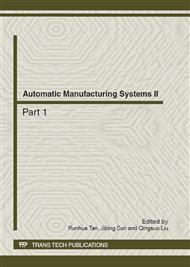p.810
p.814
p.818
p.822
p.828
p.833
p.838
p.842
p.846
Research on Calibration Method of Tire Dynamic Balance Detection System
Abstract:
Tire dynamic balance detection plays an important part in tire quality detection area. This paper uses the two-sided balance method to obtain the unbalance of the tire. According to the engineering practice, builds kinetic model and then introduces the calculating principle and operating procedures. In order to accurately determine the influence coefficient, a calibration method without tire is put forward. Further more, this new method is able to eliminate the unbalance caused by non-quality factors to some extent. But this method is presented based on the relative position invariance of the upper rim and lower rim, even both of them are under high-speed rotation situation. Finally, the experimental data acquired from both of the two methods are compared. The calibration method without tire is proved to be more feasible, efficient and accurate.
Info:
Periodical:
Pages:
828-832
Citation:
Online since:
June 2012
Authors:
Price:
Сopyright:
© 2012 Trans Tech Publications Ltd. All Rights Reserved
Share:
Citation:


